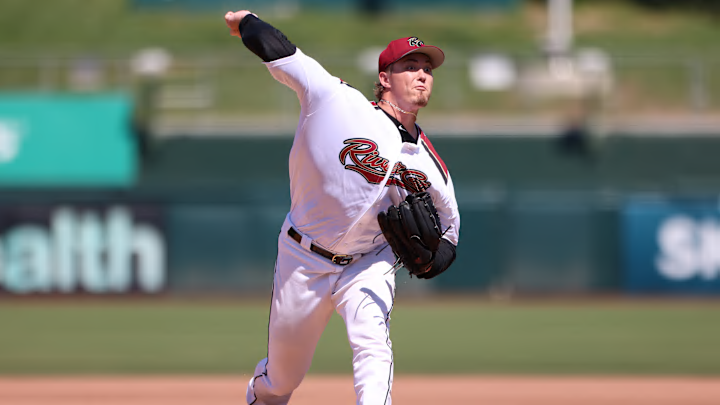New SF Giants pitching prospect Blade Tidwell completed six strong innings with seven strikeouts in a 4-2 loss to the Round Rock Express. That was his third quality, and it is hard to ignore that the results have followed an interesting change in pitch mix.
New SF Giants pitching prospect excelling with change in pitch mix since trade
When the Giants traded for Tidwell, he led with a mid-90's four-seam fastball, followed by a low-80's sweeper and sinker. Since joining San Francisco, he has led with his sweeper and a power slider, while the four-seamer has taken a backseat.
Tidwell still throws a mid-90's fastball, but he is leaning more on his sinker now. His four-seam fastball was vulnerable against left-handed hitters, but the sinker has plenty of armside movement that moves away from left-handed bats.
In Friday's game, Tidwell threw 26 sweepers, followed by 25 sliders and 23 sinkers. The four-seam fastball and changeup were lightly used.
The 24-year-old pitcher induced 13 swings, including six whiffs, against his sweeper and 15 swings, including seven whiffs, against his slider. That is a 46 percent whiff rate for his sweeper, and a 47 percent whiff rate for his slider. In total, Tidwell was second among Triple-A pitchers on Friday with 16 whiffs.
The number of whiffs is an important stat. Some numbers in Triple-A, especially the Pacific Coast League, can be misleading such as ERA and home-run rates. Strikeouts, walks, velocity, and whiffs are some important numbers to monitor. Can a pitcher get opposing hitters to swing and miss at a good rate? That trait is paramount to being an effective pitcher in the majors.
Tidwell has a starter's pitch mix. He is able to hold velocity deep into his starts, and has two quality secondary offers. In fact, the sweeper has a 44.9 percent whiff rate while the slider has a 33.3 percent whiff rate. The stuff has not been the question, but his strike-throwing ability has left something to be desired.
Since the trade, Tidwell has posted a 2.8 BB/9 rate, down considerably from a 4.5 BB/9 rate throughout his four seasons in the minors. What has led to the improvement? As Matthew Knauer notes, some pitchers tend to have a better feel for their secondary pitches. The fastball is a reliable pitch for many pitchers because it usually has a high strike rate. Landen Roupp is an example of a pitcher who often shows a better feel for his curveball than his fastball.
For Tidwell, the change in pitch mix could not only be leading to better strikeout numbers, but improved control as well. He might be one of the more interesting Giants prospects to monitor in the final six weeks of the year.
More from Around the Foghorn:
